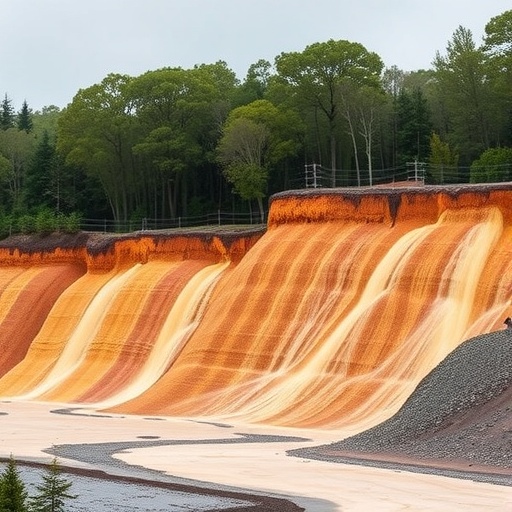In a remarkable advancement in natural hazard prediction, researchers have unveiled a sophisticated model that dramatically enhances the precision of landslide susceptibility assessments by integrating the complex interplay of rainfall and earthquake triggers. This pioneering work, recently published in Environmental Earth Sciences, underscores the critical importance of understanding multi-hazard interactions in vulnerable terrains, offering valuable insights for disaster risk reduction and land use planning worldwide.
Landslides represent a perennial threat in many mountainous and steeply sloped regions, frequently exacerbated by antecedent weather conditions and seismic activities. While previous models mainly focused on single factors such as rainfall intensity or seismic tremors independently, the new approach developed by Zeng, Zhang, Xiao, and their collaborators delves into the coupling effects—that is, how rainfall and earthquakes jointly influence slope stability. Such synergy between external forces has long been suspected to elevate landslide risks but remained challenging to quantify until now.
The essence of the breakthrough lies in the refined assessment framework that integrates hydrological dynamics with seismic shaking parameters into a cohesive predictive algorithm. By incorporating real-time and historical datasets related to precipitation patterns and earthquake magnitudes, the model calculates a susceptibility index that is remarkably sensitive to the fluctuations induced by combined triggering mechanisms. This dual-factor methodology represents a paradigm shift from conventional monovariate risk models to a more holistic multifactorial risk assessment tool.
From a technical standpoint, the model leverages advanced statistical techniques and machine learning algorithms that interpret nonlinear interactions between rainfall-induced pore water pressure elevations and earthquake-generated ground accelerations. The researchers harnessed geospatial information systems (GIS) to pattern these hazard interactions over diverse geomorphological landscapes, enabling high-resolution susceptibility mapping. This precision opens new avenues for proactive hazard identification and emergency response prioritization.
Critical to this approach is the incorporation of soil mechanics principles, notably the reduction in shear strength caused by rainfall infiltration, which primes slopes to fail when subsequently jostled by seismic waves. The model quantifies this weakening effect through parameters like hydraulic conductivity and soil cohesion, meshed with earthquake shaking intensity measures such as peak ground acceleration (PGA) and spectral acceleration values. This scientifically rigorous coupling framework reflects a deeper mechanistic understanding than prior empirical models.
The research team validated their model against well-documented landslide events in regions prone to both intense tropical rainfall and frequent seismic activity. In these validation exercises, their integrated model significantly outperformed traditional models by accurately predicting landslide occurrence with higher recall and precision rates. Such validation underscores the model’s robustness and practical applicability in real-world hazard mitigation programs.
One of the striking implications of this research is its potential utility in early warning systems. By continuously monitoring rainfall accumulation and seismic activity indicators, authorities could deploy this model in near real-time to forecast landslide susceptibility spikes, allowing timely evacuation orders and infrastructure safeguarding measures. This capability could revolutionize disaster management, minimizing loss of life and economic damage in vulnerable communities.
This multi-hazard modeling also invites a reexamination of current land use policies, especially in regions undergoing rapid urban expansion into hilly terrains. The refined susceptibility maps can guide planners to avoid highly risky zones or implement engineering controls such as slope reinforcement and drainage improvements in susceptible areas. Consequently, infrastructure resilience could be enhanced in disaster-prone regions around the globe.
Moreover, the implications extend beyond immediate hazard prediction. The framework proposed by Zeng and colleagues opens new possibilities for climate change impact studies, given projections for increasing rainfall variability and seismic risks induced by anthropogenic activities. Understanding the coupled effect of these natural forces equips scientists and policymakers with a predictive lens to anticipate evolving geohazard landscapes in a warming world.
From a scientific methodology viewpoint, the integration of real-time sensor data into the dynamic version of the model promises significant progress. As sensor networks measuring both hydrological and seismic parameters continue to expand, this could fuel continuous model updates enhancing prediction accuracy. The adaptive learning components embedded in the model are primed for such data streams, marking a future direction brimming with potential.
Despite the breakthrough, the authors acknowledge that challenges remain. Data scarcity and variability in some mountainous regions can limit the immediate applicability of the model, calling for enhanced monitoring infrastructure. Furthermore, calibrating the model to account for local geological heterogeneities, vegetation cover effects, and anthropogenic modifications requires ongoing research efforts.
The contribution of this refined coupled rainfall-earthquake landslide susceptibility model stands as a compelling example of how interdisciplinary research—merging geotechnical engineering, hydrology, seismology, and data science—can yield transformative tools for environmental risk management. It exemplifies the kind of integrative thinking needed to confront the multifaceted nature of natural disasters in the 21st century.
Looking ahead, the authors suggest expanding the framework to incorporate other potential landslide triggers, such as snowmelt and human activities like mining and deforestation. Furthermore, coupling this approach with socioeconomic vulnerability assessments could lead to comprehensive disaster risk reduction strategies that not only identify hazards but also focus on human resilience.
In summary, this innovative research marks a significant leap toward sophisticated, multi-dimensional natural hazard modeling. By capturing the nuanced interactions between rainfall and seismic forces that precipitate landslides, it equips communities and governments with sharper tools to foresee, prepare for, and ultimately mitigate the impacts of these devastating events. As climate change and urban pressures continue to reshape vulnerable landscapes, advancements like this underscore the importance of science-led strategies to safeguard lives and livelihoods.
Subject of Research: Landslide susceptibility modeling considering the coupling effects of rainfall and earthquakes.
Article Title: A refined assessment model for landslide susceptibility under rainfall-earthquake coupling effects.
Article References: Zeng, Y., Zhang, Y., Xiao, S. et al. A refined assessment model for landslide susceptibility under rainfall-earthquake coupling effects. Environ Earth Sci 84, 662 (2025). https://doi.org/10.1007/s12665-025-12552-2
Image Credits: AI Generated




